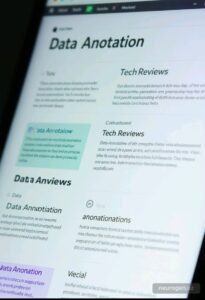In today’s AI-driven world, the importance of high-quality data can’t be overstated. At the heart of every effective machine learning model lies meticulously annotated data — and that’s where data annotation technologies step in. Whether it’s labeling images, transcribing audio, or tagging text, these tools play a critical role in teaching machines how to understand and make decisions.

This article walks you through some of the leading data annotation platforms on the market, exploring their strengths, limitations, and what to look for when choosing one for your AI projects.
What Exactly Is Data Annotation?
Data annotation is the process of adding descriptive labels to raw data like images, audio, video, or text so that machines can recognize patterns, derive meaning, and make informed predictions. For instance, tagging objects in an image (like “car,” “tree,” or “person”) helps a computer vision model identify them in real time.
It’s a demanding process — often requiring human annotators to manually tag each data point with precision. While time-consuming, it’s a critical phase in training accurate and reliable AI systems.
Top Data Annotation Tools & Platforms: Reviewed
1. Labelbox
Labelbox is widely known for its intuitive interface and flexible annotation capabilities. It supports multiple data types — images, video, text — and offers collaboration features for enterprise teams. Its scalability makes it a solid pick for startups and large organizations alike.
2. Hugging Face
Although best known for its NLP models, Hugging Face also provides datasets and annotation tools that allow users to fine-tune and adapt pre-trained models for specific tasks. It’s a favorite among developers working on text classification, sentiment analysis, and conversational AI.
3. Scale AI
Scale AI combines automation with human validation to deliver precise annotations at scale. Its platform includes 2D/3D image labeling, LiDAR point cloud annotation, and even document transcription — making it ideal for autonomous vehicle projects and advanced ML pipelines.
4. Appen
Appen is a veteran in the field, with a global workforce of annotators and a robust platform for managing annotation tasks. It’s trusted by enterprises in e-commerce, healthcare, and finance, offering everything from audio transcription to image tagging with rigorous quality checks.
5. V7 Labs
V7 (formerly known as V7 Darwin) is a newer but powerful platform focused on computer vision annotation. It supports automated labeling with AI assistance, medical imaging tools, and collaborative review processes — perfect for research-driven projects.
Features to Look for in a Data Annotation Platform
When evaluating data annotation technologies, keep the following features in mind:
Support for Diverse Data Types: Whether you’re working with video, sensor data, or conversational text, ensure the platform can handle it.
Annotation Tools Variety: From simple bounding boxes to complex polygons, different tasks require different labeling tools.
Scalability: Opt for platforms that can scale with your dataset size and team growth, especially for enterprise-level ML pipelines.
Quality Assurance Mechanisms: Built-in review systems, consensus checks, and annotator performance metrics are crucial for maintaining accuracy.
Workflow Integration: Ensure seamless integration with your existing ML stack (e.g., AWS, TensorFlow, or PyTorch).
Team Collaboration: Features like user roles, comment threads, and live reviews streamline teamwork and save valuable time.
Why Use Data Annotation Technology?
Investing in the right annotation platform comes with several key benefits
Higher Model Accuracy: Properly labeled data leads to better model predictions and fewer false positives or errors
Improved Efficiency: Automation and smart tools reduce manual effort, accelerating your development pipeline.
Scalable Operations: Easily manage and expand projects as your data needs grow.
Conclusion
In conclusion, data annotation technologies are a crucial component of developing accurate and reliable AI models. By leveraging the right platform, teams can deliver high-quality annotated data, improving the performance and reliability of their models. When selecting a data annotation platform, consider the key features outlined above, such as support for diverse data types, annotation tools variety, scalability, quality assurance mechanisms, workflow integration, and team collaboration.
This is the reason why you should do it:
– Achieve higher model accuracy
– Improve efficiency
– Scale operations
– Enhance collaboration
Ultimately, the right data annotation platform can help teams unlock the full potential of their AI projects, driving innovation and success in a rapidly evolving technological landscape.









